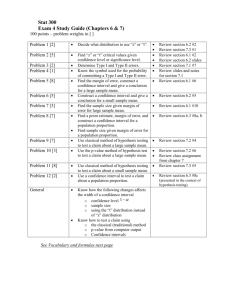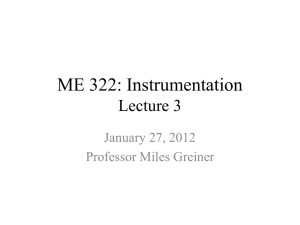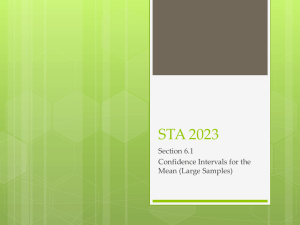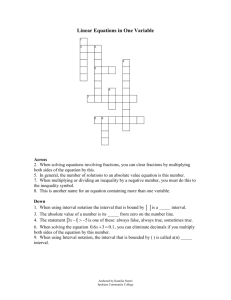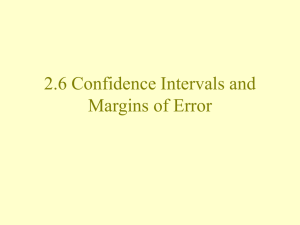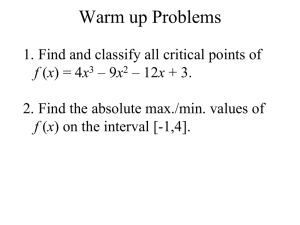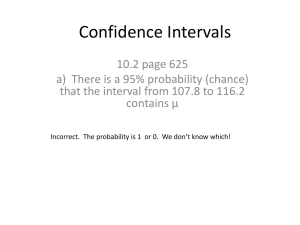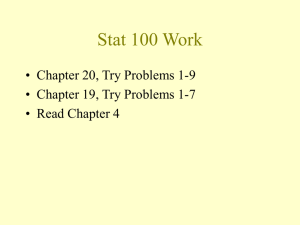S501 HW#4 --
advertisement
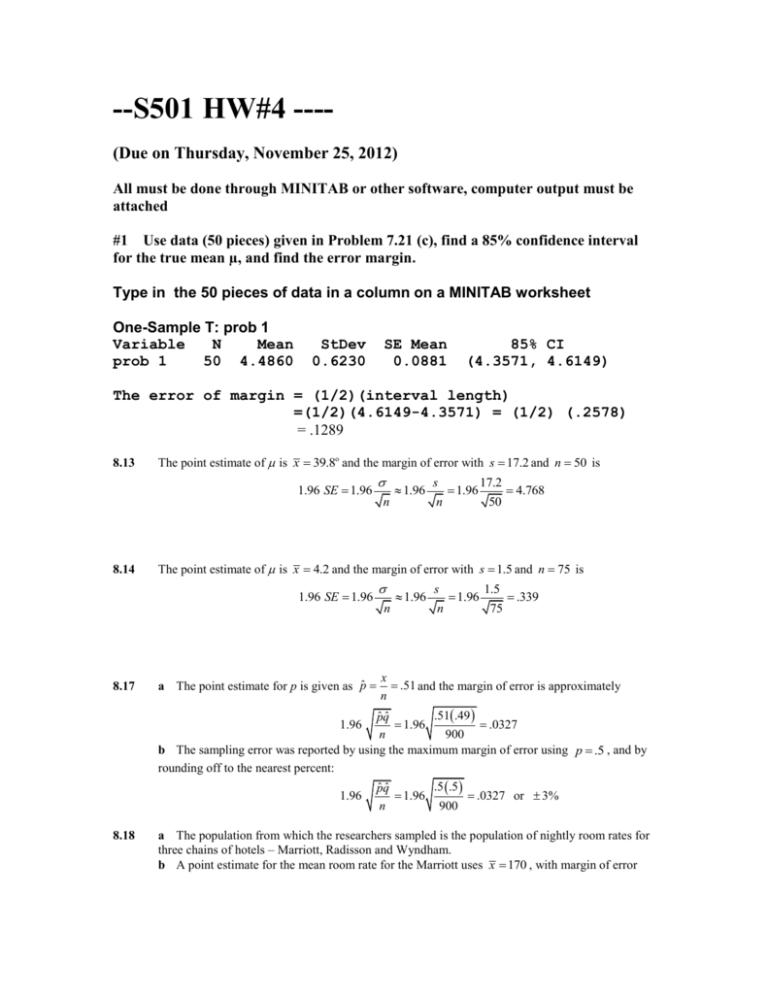
--S501 HW#4 ---(Due on Thursday, November 25, 2012) All must be done through MINITAB or other software, computer output must be attached #1 Use data (50 pieces) given in Problem 7.21 (c), find a 85% confidence interval for the true mean µ, and find the error margin. Type in the 50 pieces of data in a column on a MINITAB worksheet One-Sample T: prob 1 Variable N Mean prob 1 50 4.4860 StDev 0.6230 SE Mean 0.0881 85% CI (4.3571, 4.6149) The error of margin = (1/2)(interval length) =(1/2)(4.6149-4.3571) = (1/2) (.2578) = .1289 8.13 The point estimate of is x 39.8o and the margin of error with s 17.2 and n 50 is 1.96 SE 1.96 8.14 n 1.96 s n 1.96 17.2 50 4.768 The point estimate of is x 4.2 and the margin of error with s 1.5 and n 75 is 1.96 SE 1.96 8.17 a The point estimate for p is given as pˆ n 1.96 s n 1.96 1.5 75 .339 x .51 and the margin of error is approximately n .51.49 ˆˆ pq 1.96 .0327 n 900 b The sampling error was reported by using the maximum margin of error using p .5 , and by rounding off to the nearest percent: 1.96 1.96 8.18 .5 .5 ˆˆ pq 1.96 .0327 or 3% n 900 a The population from which the researchers sampled is the population of nightly room rates for three chains of hotels – Marriott, Radisson and Wyndham. b A point estimate for the mean room rate for the Marriott uses x 170 , with margin of error 1.96 SE 1.96 1.96 s 1.96 17.5 4.85 n n 50 c A point estimate for the mean room rate for the Radisson uses x 145 , with margin of error s 10 1.96 SE 1.96 1.96 1.96 2.77 n n 50 d A point estimate for the mean room rate for the Wyndham uses x 150 , with margin of error s 16.5 1.96 SE 1.96 1.96 1.96 4.57 n n 50 e The graphical comparison of parts b, c and d is shown below. The Radisson seems to have lower and less variable rates than the other two hotels. 200 Avg Room Rate 150 100 50 0 Marriott Radisson Wyndham Hotel 8.30 With n 30, x 145 and s .0051 , a 90% confidence interval for is approximated by x 1.645 s n .145 1.645 .0051 30 .145 .0015 or .1435 .1465 One-Sample T N 30 8.31 Mean 0.145000 StDev 0.005100 SE Mean 0.000931 90% CI (0.143418, 0.146582) With n 40, x 3.7 and s .5 and .01 , a 99% confidence interval for is approximated by x 2.58 s n 3.7 2.58 .5 40 3.7 .204 or 3.496 3.904 In repeated sampling, 99% of all intervals constructed in this manner will enclose . Hence, we are fairly certain that this particular interval contains . (In order for this to be true, the sample must be randomly selected.) One-Sample T N Mean StDev 40 3.7000 0.5000 SE Mean 0.0791 99% CI (3.4859, 3.9141) We assumed that the PH values follow a normal distribution in order that the confidence interval is valid. 8.32 a An approximate 95% confidence interval for p is pˆ 1.96 or .54 .46 ˆˆ pq .54 1.96 .54 .049 n 400 .491 p .589 . Test and CI for One Proportion Sample X N Sample p 1 216 400 0.540000 95% CI (0.489766, 0.589638) b An approximate 95% confidence interval for p is .30 .70 ˆˆ pq pˆ 1.96 .30 1.96 .30 .048 n 350 or .252 p .348 . Test and CI for One Proportion Sample X N Sample p 1 105 350 0.300000 8.34 95% CI (0.252434, 0.350988) a The 90% confidence interval for p is pˆ 1.645 or .39 .61 ˆˆ pq .39 1.645 .39 .025 n 1002 .365 p .415 . Test and CI for One Proportion Sample X N Sample p 1 391 1002 0.390220 90% CI (0.364637, 0.416282) b The 90% confidence interval for p is pˆ 1.645 .53 .47 ˆˆ pq .53 1.645 .53 .026 n 1002 or .504 p .556 . Test and CI for One Proportion Sample 1 8.45 X 531 N 1002 Sample p 0.529940 90% CI (0.503466, 0.556284) a The point estimate of the difference 1 2 is x1 x2 53,659 51,042 2617 and the margin of error is 1.96 12 n1 22 n2 1.96 22252 23752 902.08 50 50 b Since the estimate of the difference 1 2 is 2617 902.08 1714.92 which is greater than the margin error ─ it seems that there is a significant difference in starting salaries, it is likely that the mean for chemical engineering majors is larger than the mean for computer science majors. 8.48 a The 99% confidence interval for 1 2 is approximately x1 x2 2.58 s12 s22 n1 n2 42 10 2 30 40 8 4.49 or 12.49 1 2 3.51 15 23 2.58 Two-Sample T-Test and CI Sample N Mean StDev SE Mean 1 30 15.00 4.00 0.73 2 40 23.0 10.0 1.6 Difference = mu (1) - mu (2) Estimate for difference: -8.00 99% CI for difference: (-12.65, -3.35) b Since the confidence interval in part a has two negative endpoints, it does not contain the value 1 2 0 . Hence, it is not likely that the means are equal. It appears that there is a real difference in the mean times to completion for the two groups. 8.57 a With pˆ1 x1 x .62 and pˆ 2 2 .35 . The approximate 99% confidence interval is 96 105 pˆ1 pˆ 2 2.58 pˆ1qˆ1 pˆ 2 qˆ2 n1 n2 .62 .38 .35 .65 96 105 .27 .175 or .095 p1 p2 .445 .62 .35 2.58 Test and CI for Two Proportions Sample X N Sample p 1 60 96 0.625000 2 37 105 0.352381 Difference = p (1) - p (2) Estimate for difference: 0.272619 99% CI for difference: (0.0976366, 0.447602) 8.59 b Since the value p1 p2 0 is not in the confidence interval, it is not likely that p1 p2 . You should conclude that there is a difference in the proportion of people with colds for the two groups. c The data shows the opposite effect from what you might expect. It appears that coming into contact with more people actually decreases the probability of getting a cold. Perhaps the more you are out among a variety of people, the more immune your system becomes to cold germs and viruses. Calculate pˆ1 x1 120 x 54 .7 and pˆ 2 2 .54 . The approximate 90% confidence interval n1 180 n2 100 is pˆ1 pˆ 2 1.645 pˆ1qˆ1 pˆ 2 qˆ2 n1 n2 .7 .3 .54 .46 180 100 .16 .099 or .061 p1 p2 .259 .7 .54 1.645 Test and CI for Two Proportions Sample X N Sample p 1 126 180 0.700000 2 54 100 0.540000 Difference = p (1) - p (2) Estimate for difference: 0.16 90% CI for difference: (0.0606167, 0.259383) Intervals constructed in this manner will enclose the true value of p1 p2 90% of the time in repeated sampling. Hence, we are fairly certain that this particular interval encloses p1 p2 . Since the interval does not include zero, it is likely that the percentage of first born for graduates is significantly higher than that of nongraduates. 8.68 It is necessary to find the sample size required to estimate a certain parameter to within a given bound with confidence 1 . Recall from Section 8.5 that we may estimate a parameter with 1 confidence within the interval (estimator) z 2 (std error of estimator). Thus, z 2 (std error of estimator) provides the margin of error with 1 confidence. The experimenter will specify a given bound B. If we let z 2 (std error of estimator) B , we will be 1 confident that the estimator will lie within B units of the parameter of interest. For this exercise, the parameter of interest is , B 1.6 and 1 .95 . Hence, we must have 1.96 n 1.6 1.96 n 1.96 12.7 12.7 n 1.6 15.5575 1.6 n 242.04 or n 243 8.69 pq . Assuming n maximum variation, which occurs if p .3 (since we suspect that .1 p .3 ) and z.025 1.96 , we have For this exercise, B .04 for the binomial estimator p̂ , where SE pˆ 1.96 pˆ B 1.96 .3 .7 1.96 8.70 n n 1.96 .3 .7 .04 n 504.21 or n 505 In this exercise, the parameter of interest is 1 2 , n1 n2 n , and 12 22 27.8 . Then we must have z 2 (std error of x1 x2 ) B 1.645 n 8.71 .04 pq B n 12 n1 22 n2 .17 1.645 27.8 27.8 .17 n n 1.645 55.6 n 5206.06 or n1 n2 5207 .17 In this exercise, the parameter of interest is p1 p2 , n1 n2 n , and B .05 . Since we have no prior knowledge about p1 and p2 , we assume the largest possible variation, which occurs if p1 p2 .5 . Then z 2 (std error of pˆ1 pˆ 2 ) B z.01 p1q1 p2 q2 .05 2.33 n1 n2 n 8.91 .5.5 .5.5 n n .05 2.33 .5 n 1085.78 or n1 n2 1086 .05 a Define sample #1 as the sample of 482 women and sample #2 as the sample of 356 men. Then pˆ1 .5 and pˆ 2 .75 . b The approximate 95% confidence interval is pˆ qˆ pˆ qˆ pˆ1 pˆ 2 1.96 1 1 2 2 n1 n2 .5 .5 .75 .25 482 356 .25 .063 or .313 p1 p2 .187 .5 .75 1.96 c Since the value p1 p2 0 is not in the confidence interval, it is unlikely that p1 p2 . Since all the probable values of p1 p2 are negative, the proportion of men of Wall Street who have children appears to be larger than the proportion of women. 8.92 The best sample estimator for the mean is x xi n . Therefore, the estimated value of is x 9.7 . One-Sample T N Mean StDev 35 9.700 5.800 SE Mean 0.980 95% CI (7.708, 11.692) The margin of error is E= (1/2)(11.692-7.708)= 1.992 (the computer used a better approximation rather than plain CLT) or s 5.8 1.96 x 1.96 1.96 1.96 1.92 n n 35 The population in this exercise is the difference in blood pressure for all collegeaged smokers between the beginning of the experiment and five years later. 8.102 Using the range approximation to obtain an estimate of , we have R 13, 000 4800 2050 4 4 and the desired value of n is obtained: 2050 1.96 B 1.96 500 n 64.58 or n 65 n n 8.103 It is assumed that p .2 and that the desired bound is .01. Hence, 1.96 8.107 1.96 .05 .95 pq .01 n 42.72 n .01 n 1824.76 or n 1825 a The approximate 95% confidence interval for is x 1.96 or 2.837 3.087 . s n 2.962 1.96 .529 69 2.962 .125 One-Sample T N 69 Mean 2.9620 StDev 0.5290 SE Mean 0.0637 95% CI (2.8349, 3.0891) b In order to cut the interval in half, the sample size must increase by 4. If this is done, the new half-width of the confidence interval is 1 1.96 1.96 . 2 4n n Hence, in this case, the new sample size is 4 69 276 . 7.75 Type in the 25 defective numbers on column, say, Defectives Use calculator to compute Def-Rate = Defectives / 100 a Construction of a p chart based on data. The average proportion of defectives is .04 .02 .03 p .032 25 and the control limits are UCL p 3 p (1 p ) .032(.968) .032 3 .0848 n 100 p (1 p ) .032(.968) .032 3 .0208 n 100 If subsequent samples do not stay within the limits, UCL .0848 and LCL 0 , the process should be checked. LCL p 3 and Problem #7.75 Defective Rate Control Chart (n=100) 0.10 UCL=0.0863 Individual Value 0.08 0.06 0.04 _ X=0.032 0.02 0.00 -0.02 LCL=-0.0223 1 3 5 7 9 11 13 15 Observation 17 19 21 23 25 b From part a, we must have pˆ .0848 . c An erroneous conclusion will have occurred if in fact p .0848 and the sample has produced pˆ .15 by chance. One can obtain an upper bound on the probability of this particular type of error by calculating P pˆ .15 when p .0848 . 7.78 ( Plot 30 observed data against a specified control chart) a If the process is in control, the mean weight per can is 21 ounces, and the standard deviation is 1.2 ounces. . With n 5 , the upper and lower control limits are 21 ± 3 ( 1.2 / SQRT(5) ) = 21 ± 3 (.5366) = 21 ± 1.61 or CLC= 21 – 1.61 = 19.39, and UCL= 21 + 1.61 = 22.61 b . Using specification. Mean =21, SE of Average weight of 5 cans = 1.2 / SQRT(5) = 0.5366 Stat Control Charts Variable for individuals Individuals Fill in Variable Name, Click ‘I Chart Options’ , fill in Mean =21, and Standard deviation = .5366, OK, OK Problem #7.78 Average Weight Control Chart Using Specification 1 23 1 Individual Value UCL=22.610 22 _ X=21 21 20 LCL=19.390 19 1 4 7 10 13 16 19 Observation 22 25 28 Two samples exceed the bounds (#1, #18); the process is probably out of control at these two time points. Descriptive Statistics: AvgWeight Variable N Mean SE-Mean StDev AvgWeight 30 21.20 0.144 0.788 Variable AvgWeight Min Q1 Q2 Q3 19.9 20.55 21.30 21.600 Maximum 23.100 The average weight for the 30 samples is 21.2 ounces which is a little bit higher than the specification. The StDev (the standard deviation of the average of 5 cans) is 0.788 which is also higher than the specification of 0.5366 ounces.
